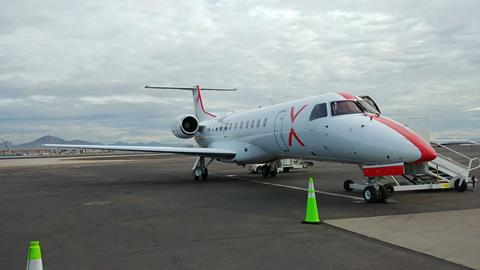The Federal Aviation Administration intends to subject operators of so-called “public charter” flights to the same rules that major scheduled airlines must follow, a move supported by some of those airlines and by the USA’s largest pilot union.
The agency disclosed its plan on 17 June but also said it will study whether to create a new category for scheduled flights under its charter-aircraft rules – move aimed at possibly benefiting smaller airlines and smaller communities.
“If a company is effectively operating as a scheduled airline, the FAA needs to determine whether those operations should follow the same stringent rules as scheduled airlines,” says FAA administrator Mike Whitaker.

Schedule flights operated by major US airlines are subject to the FAA’s Part 121 operating rules.
Charter airlines, however, operate under the FAA’s Part 135 charter rules, which do not allow for scheduled flights except under an exemption for public charters. Such flights are arranged by one company and operated by a charter airline using aircraft with 30 or fewer seats.
Public charters have been around for decades. But a new and expanding player called JSX has stirred controversy in recent months. Critics, including the Air Line Pilots Association (ALPA), American Airlines and Southwest Airlines urged the FAA to eliminate what they describe as a safety loophole.
The FAA in October 2023 solicited comments from the public about whether it should address concerns about public charters.
On 17 June the agency said it has decided to move forward “expeditiously” with changes to subject public charters to the same rules as large scheduled airlines.
“If finalised, the effect of this proposed rule change would be that public charters will be subject to operating rules based on the same safety parameters as other non-public charter operations,” the FAA says.
ALPA president Jason Ambrosi says the FAA has taken “decisive action to close the public charter loophole and ensure one level of safety for passengers and flight crews”.
But while the FAA intends to eliminate the public charter model, it also plans to examine other possible rule changes aimed at “expanding air service to small and rural communities”.
“Specifically, the FAA will convene a safety risk management panel to assess the feasibility of a new operating authority for scheduled Part 135 operations in 10-30 seat aircraft,” the agency says.
It does not elaborate.
Dallas-based JSX says it “applauds FAA Administrator Whitaker’s plans to evaluate a new operating authority for certain Part 135 operations”. It does not comment about the FAA’s plans to curtail public charters.
JSX operates 30-seat Embraer ERJ-135s and ERJ-145s on several dozen routes, most across the southwest USA.
US airline lobby group Airlines for America declines to comment. The Regional Airline Association did not respond to request for comment.
The FAA’s public-charter move comes a troubled time for regional air service in the USA. Over many decades factors including pilot shortages, airline consolidations and the lack of new-design small commercial aircraft have led to a significant decline in air service to small communities.


























